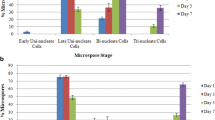Summary
Brassica napus cv. Topas microspores, isolated and cultured near the time of the first pollen mitosis and subjected to a heat treatment of 24 h, can be induced to develop into haploid embryos. This is a study of microspore structure during induction and embryo determination. Early during the 32.5 °C incubation period the nucleus moved away from the edge of the cell, and granules, 30 to 60 nm in diameter, appeared in the mitochondria and as a cluster in the cytoplasm. Cells divided symmetrically and at the end of the heat treatment, acquired the features of induced bicellular structures described previously. The features persisted as the cells divided randomly within the exine for 4–7 days following heat induction. Multicellular structures released from the exine underwent periclinal divisions resulting in protoderm differentiation of the globular embryo, thus determining embryo development. The cytoplasm of early heart-stage embryos contains abundant polyribosomes. Non-embryogenic development was indicated by large accumulations of starch and/or lipid and thickened cell walls or an unorganized pattern of cell division following release of the multicellular structures from the exine. Embryogenesis is discussed in terms of induction, embryo determination and development.
Similar content being viewed by others
References
Bruck DK, Walker DB (1985) Cell determination during embryogenesis inCitrus jambhiri. II. Epidermal differentiation as a one time event. Amer J Bot 72: 1602–1609
Dubois T, Guedira M, Dubois J, Vasseur J (1991) Direct somatic embryogenesis in leaves ofCichorium: a histological and SEM study of early stages. Protoplasma 162: 120–127
Dunwell JM, Sunderland N (1975) Pollen ultrastructure in anther cultures ofNicotiana tabacum III. The first sporophytic division. J Exp Bot 26: 240–252
Dylewski DP, Singh NK, Cherry JH (1991) Effects of heat shock and thermoadaptation on the ultrastructure of cowpea (Vigna unguiculata) cells. Protoplasma 163: 125–135
Fransolet S, Deltour R, Bronchart R, Van de Walle C (1979) Changes in ultrastructure and transcription induced by elevated temperature inZea mays embryonic root cells. Planta 146: 7–18
Fulcher RG, McCully ME, Setterfield G, Sutherland J (1976) B-1,3-glucans may be associated with cell plate formation during cytokinesis. Can J Bot 54: 539–542
Garrido D, Eller N, Herberle-Bors E, Vicente O (1993) De novo transcription of specific mRNAs during the induction of tobacco pollen embryogenesis. Sex Plant Reprod 6: 40–45
Heberle-Bors E (1989) Isolated pollen culture in tobacco: plant reproductive development in a nutshell. Sex Plant Reprod 2: 1–10
Hoson T, Masuda Y, Nevins DJ (1992) Comparison of the outer and inner epidermis, inhibition of auxin-induced elongation of maize coleoptiles by glucan antibodies. Plant Physiol 98: 1298–1303
Kutschera U, Bergfeld R, Schopfer P (1987) Cooperation of epidermis and inner tissues in auxin-mediated growth of maize coleoptiles. Planta 170: 168–180
Maheswaran G, Williams EG (1985) Origin and development of somatic embryoids formed directly on immature embryos ofTrifolium repens in vitro. Ann Bot 56: 619–630
Mansfield MA, Lingle WL, Key JL (1988) The effects of lethal heat shock on nonadapted and thermotolerant root cells ofGlycine max. J Ultrastruct Res 99: 96–105
Nover L, Scharf K-D, Neumann D (1983) Formation of cytoplasmic heat shock granules in tomato cell cultures and leaves. Mol Cell Biol 3: 1648–1655
— — — (1989) Cytoplasmic heat shock granules are formed from precursor particles and are associated with a specific set of mRNAs. Mol Cell Biol 9: 1298–1308
Pechan PM, Bartels D, Brown DCW, Schell J (1991) Messenger-RNA and protein changes associated with induction ofBrassica microspore embryogenesis. Planta 184: 161–165
Raghavan V (1978) Origin and development of pollen embryoids and pollen calluses in cultured anther segments ofHyoscyamus niger. Amer J Bot 65: 984–1002
Rashid A, Siddiqui AW, Reinert J (1982) Subcellular aspects of origin and structure of pollen embryos ofNicotiana. Protoplasma 113: 202–208
Sangwan-Norreel BS (1978) Cytochemical and ultrastructural peculiarities of embryogenic pollen grains and of young androgenic embryos inDatura innoxia. Can J Bot 56: 805–817
Seagull RW (1992) Commentary: the hormonal regulation of cell elongation through changes in microtubule orientation. Int J Plant Sci 153: iii-iv
Tanaka I, Ito M (1981) Control of division patterns in explanted microspores ofTulipa gesneriana. Protoplasma 108: 329–340
Telmer CA, Simmonds DH, Newcomb W (1992) Determination of developmental stage to obtain high frequencies of embryogenic microspores inBrassica napus. Physiol Plant 84: 417–424
—, Newcomb W, Simmonds DH (1993) Microspore development inBrassica napus and the effect of high temperature on division in vivo and in vitro. Protoplasma 172: 154–165
Vicente O, Benito Moreno RM, Heberle-Bors E (1991) Pollen cultures as a tool to study plant development. Cell Biol Rev 25: 295–305
Zaki MAM, Dickinson HG (1990) Structural changes during the first divisions of embryos resulting from anther and free microspore culture inBrassica napus. Protoplasma 156: 149–162
— — (1991) Microspore-derived embryos inBrassica: the significance of division symmetry in pollen mitosis I to embryogenic development. Sex Plant Reprod 4: 48–55
Author information
Authors and Affiliations
Rights and permissions
About this article
Cite this article
Telmer, C.A., Newcomb, W. & Simmonds, D.H. Cellular changes during heat shock induction and embryo development of cultured microspores ofBrassica napus cv. Topas. Protoplasma 185, 106–112 (1995). https://doi.org/10.1007/BF01272758
Received:
Accepted:
Issue Date:
DOI: https://doi.org/10.1007/BF01272758




